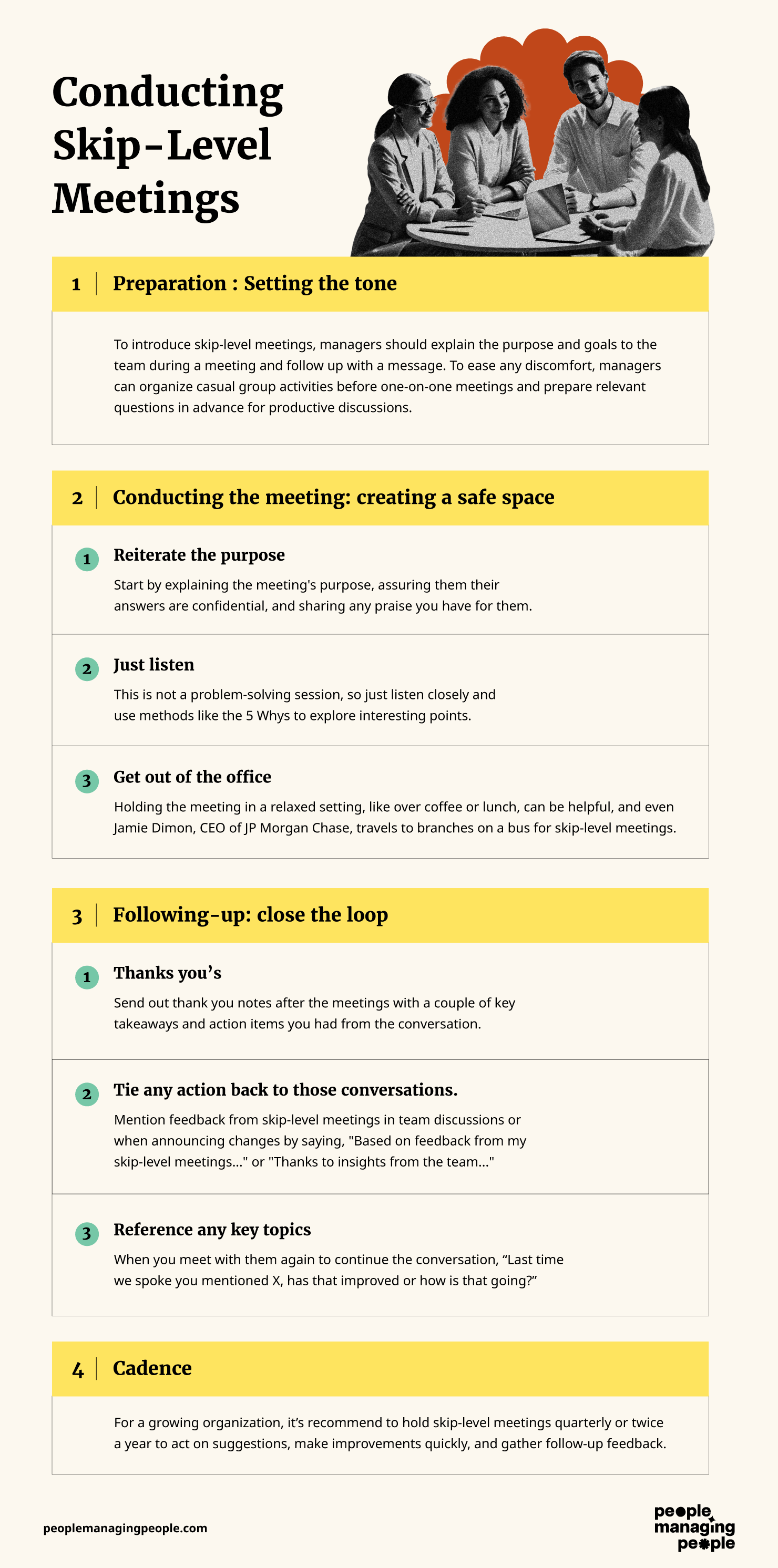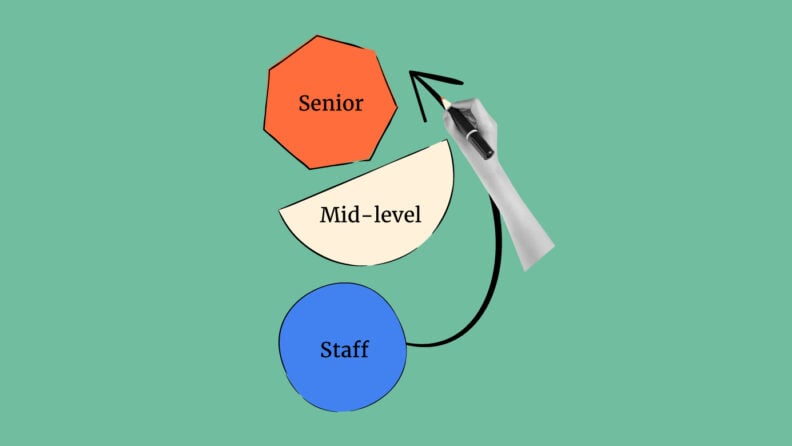Skip-level meetings are when a senior leader connects with a worker two or more levels beneath them. The purpose is to get a clearer view of life on the frontlines of the organization.
As an HR leader for almost twenty years, I’ve coached countless managers and leaders on combining skip-level meetings with employee engagement software to help boost employee engagement and drive positive organizational change.
In this article, I’ll show you the value they can bring to your organization and how to have impactful skip-level conversations.
What Is A Skip-Level Meeting?
A skip-level meeting is a conversation between a senior manager and someone who reports to one of their direct reports (i.e. individual contributor). The mid-level manager is not in the meeting, they’re “skipped over” to talk to lower-level employees.
The purpose of skip-level meetings is to gather feedback that will ultimately help guide decision-making.
They help senior leaders understand what employees care about, their pain points, their reasons for excitement and motivation, and their opinions of their managers.
They also create more visibility, build rapport and trust, and foster better relationships between leaders and front-line employees.
Conducting Skip-Level Meetings
Skip-level meetings aren't rocket science, but they should be approached systematically to together effective feedback.
Here’s the process I provide to leaders and organizations who want to conduct skip levels.

1. Preparation: Setting the tone
If this is the first time you’re considering holding skip-level meetings, there are a few ways to ease people into speaking to their boss’s boss.
Communicate in a team meeting
Managers should inform the team in a meeting about the skip-levels and what to expect. This shows they’re bought in and excited for them, and it’s not something you’re doing to exclude them or go behind their back (no “gotcha” moments).
Communicate via Slack or email
Reach out to the team with an email or Slack to reinforce the goal of the meetings, how they tie into your company values or culture (“As you know, one of our values is about learning, so I want to learn from you and see what we can be doing differently or strengthening on our team”), and next steps (example: “I’ll be reaching out to each of you individually to set up time”).
Hold a group exercise prior
Depending on your culture, and how uncomfortable or different this may feel for your team members, you may want to consider a group exercise first.
Try taking the team out to lunch (perhaps virtually) to create a more casual space for open dialogue to start, then move to one-on-ones in the next cycle.
Prepare questions beforehand
Maybe the data’s telling you a story you want to corroborate, there’s a project you want to know more about, or you’re hearing whisperings about a certain manager or team.
Whatever the case, it’s worth taking the time to prepare some questions beforehand to delve into topics that interest you most (some examples coming up).
You can share the questions with the interviewee in the calendar invite.
2. Conducting the meeting: creating a safe space
Despite the prior groundwork, it’s natural that employees may still be hesitant to share their true thoughts and feelings.
Here are some tips to get the most out of the meeting.
- Reiterate the purpose. At the beginning, reiterate the purpose of the meeting and let them know their answers will be treated confidentially. This is also a good time to share any specific praise you have for them.
- Just listen. This isn’t a troubleshooting session, so resist the urge to problem-solve. Simply listen actively and, if something interesting arises, use techniques like the 5 Whys to delve deeper.
- Get out of the office. It can also be beneficial to conduct the meeting in a less formal setting, perhaps taking them for a coffee or lunch. JP Morgan and Chase CEO, Jamie Dimon, reportedly travels around their different branches on a bus conducting skip-levels.
3. Following up: close the loop
After you’ve held your conversations, it’s crucial you do some follow-up work as well!
You want to ensure the team feels heard and that you took in their feedback to make some changes (or why you didn’t implement anything new if it didn’t make sense).
The worst outcome is that you have these conversations and people think they were just for show, so close the loop!
- Thanks you’s. Send out thank you notes after the meetings with a couple of key takeaways and action items you had from the conversation.
- Tie any action back to those conversations. Referring to them in team meetings or when announcing changes or new initiatives, “Because of the feedback I heard during my skip-level meetings….” or “Thanks to insights from the team…”
- Reference any key topics when you meet with them again to continue the conversation, “Last time we spoke you mentioned X, has that improved or how is that going?”
Cadence
Depending on the size of your organization, and how fast it changes or evolves, I’d recommend a quarterly or twice-yearly cadence for skip-levels.
This is so you have the opportunity to act on any suggestions brought up, move fast on improvements, and get follow-up feedback if any changes had the impact you intended.
Skip-level Meeting Questions
It’s important that you have some leading questions but also create the space for open dialogue and let the conversation go in the direction the employee takes it!
Here are some specific questions to help guide the conversation.
Gauging engagement levels
- On a scale of 1-10, how has this month been for you? What would have made it a 10?
- What are you most excited about right now in your role or for this team (or company)?
- What worries you or what are you most concerned about?
- What’s a recent win that you had?
Identifying team or organizational issues
- What is a roadblock that you’re currently facing?
- What is going on for the team that you think I might not be aware of (or not know enough about)?
- Is there a process you think we could improve?
- Do you know the company's goals?
Getting manager feedback
- What do you appreciate the most about your manager?
- What do you wish your direct manager did differently?
- Are you clear about what’s expected of you and what your goals are?
- What can I be doing differently as the leader of this department?
Development
- How can I help you with your career goals?
- How we can better support you as an organization?
- What do you see as the next step in your career?
- What other feedback did you have that we didn’t talk about / or / What question didn’t I ask that you wish I had?
Chat GPT prompts for developing skip-level questions
Chat GPT, you might have heard of it! It’s useful for lots of tasks including helping you generate interview questions.
Here are some prompts to help you generate some questions for skip-levels.
- Prompt #1: "Generate skip-level meeting questions focused on understanding team dynamics and morale."
- Prompt #2: "Create questions for a skip-level meeting that address employees' professional development and career goals."
- Prompt #3: "Generate insightful skip-level meeting questions about perceptions of leadership and management effectiveness.”
You get the idea! You can also check out this guide on using ChatGPT in HR.
Benefits Of Skip-Level Meetings
Skip-level meetings are powerful for both the leader and the team. Benefits include:
- Valuable feedback. Leaders get valuable insights into team members, what's important to them, and any opportunities to improve the work environment or spark change.
- Increased employee engagement. The employee walks away with a sense that you care about them and want to support them in their careers and day-to-day work.
- Create a culture of feedback. Skip-levels indicate that you’re open to feedback and this will make people more likely to provide it.
- Talent recognition and development: Skip-level meetings allow senior managers to identify and recognize potential talent. This can be crucial for succession planning and talent development initiatives.
One leader I worked with recognized through skip levels that a new organizational structure wasn’t working.
They could only get this information through direct feedback from the team because the managers weren’t sure how to present the feedback, given their position in the new structure.
Another leader I know finds skip levels to be extremely effective for hearing market feedback from team members who talk directly to clients.
They’re able to ask direct follow-up questions and get their heads around the client conversations, instead of getting the feedback second-hand through managers.
Skip Level Meeting Best Practices
Best practices for leaders in skip-level meetings
Here’s a summary of my best practices for leaders to help conduct effective skip-levels.
- Preparation: Thoroughly prepare for the meeting, understanding the team's current projects and challenges.
- Active listening: Focus on actively listening to the employee, showing genuine interest in their perspectives.
- Confidentiality: Assure and maintain confidentiality to foster a safe and open discussion environment.
- Follow-up: Commit to actionable follow-up on any concerns or suggestions raised.
- Transparency: Be transparent about the meeting's goals and how the feedback will be used.
Best practices for employees in skip-level meetings
Some tips to share with the interviewee to help them prepare and provide the most valuable feedback.
- Honesty: Be honest and constructive in sharing your views and experiences.
- Specificity: Provide specific examples or suggestions when discussing issues or improvements.
- Professionalism: Maintain professionalism, especially when discussing sensitive topics.
- Open-mindedness: Be open to providing and receiving feedback.
- Preparation: Prepare points or questions in advance to make the most of the meeting opportunity.
Skip-levels Demonstrate Strong Leadership
Being a strong, present, vulnerable, and available leader has never been more important.
While employees leave managers and companies who don't care about them, they also stay at companies where they feel heard, valued, and supported.
They stay with managers and leaders who take the time to reach out and listen and act on their feedback and make them feel heard.
Skip-level conversations are a great way to build trust, gather feedback, increase employee engagement, and retain top employees.
They form an important part of your overall employee listening strategy.
Key takeaways
- Purpose and benefits: Skip-level meetings connect senior managers with lower-level employees to improve transparency and gather direct feedback. They also help increase engagement and aid in talent identification.
- Conducting meetings: Effective skip-level meetings require preparation, active listening, confidentiality, and a concerted follow-up. Creating a comfortable environment for open discussions is crucial, and preparing specific guiding questions can help steer the conversation effectively.
- Leadership and culture impact: These meetings demonstrate strong leadership and foster a positive organizational culture. They build trust, show leadership commitment to employee feedback, and are key in retaining top talent by making employees feel valued and heard.
Join the People Managing People Community
For further support on skip-level meetings and gathering employee feedback, join the People Managing People Community, a supportive community of HR and business leaders sharing knowledge to help you progress in your career and make greater impact in your organization.


